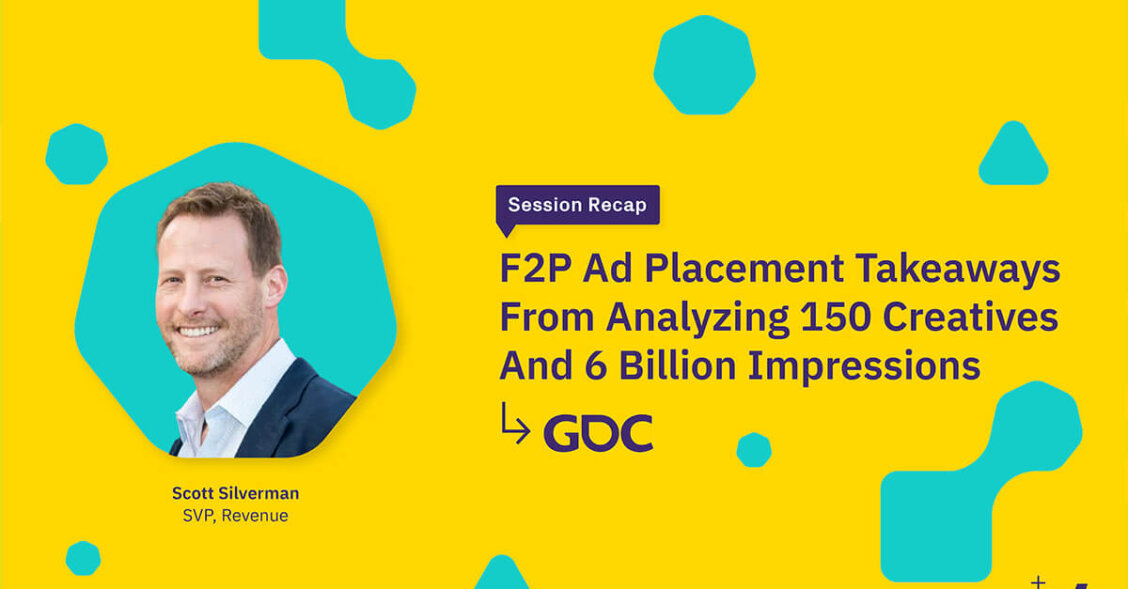
GDC Recap: F2P Ad Placement Takeaways From Analyzing 150 Creatives and 6B Impressions
The age-old question of how to balance monetizing a free-to-play mobile game with ads and maintaining a delightful player experience was answered once and for all at the Game Developers Conference 2021 (GDC 2021) by Vungle’s SVP of Revenue Scott Silverman.
In his in-depth session, he answered this question, not with one-off anecdotal evidence, but with quantitative proof, providing data-backed insights from the first-of-its-kind report of ad placements in mobile games currently monetizing through the Vungle mobile ad network. He shared findings from an analysis of over 6.3 billion impressions across more than 150 different ad placements from mobile game publishers running on Vungle. He also shared real ad placement integration examples from some of the leading mobile game developers.
Vungler in This Session
Name: Scott Silverman
What he does: A passionate entrepreneur and operator with over 2 decades of ad tech experience, Scott leads Vungle’s global Sales organization across Americas, EMEA, and APAC.
Watch This Webinar Now
Webinar Transcript
A lightly edited transcript of our session follows.
Scott:
Good afternoon, everyone. Thank you for coming and joining me. Today, I’m going to walk you through a little about game monetization through advertising. We recently did a study analyzing 150 ad placements across more than 6 billion impressions on Vungle’s network. And I’m going to walk you through the research, share some examples of ad placements from hit mobile games, and hopefully, when you leave today, you’ll walk away with some insight into best practices that can guide you as you evaluate ways to incorporate advertising into your game experience.
Before I get into the details, a little background on me. I’m Scott Silverman, the SVP of Revenue for Vungle. And I’ve been a passionate entrepreneur and operator in ad tech for over 2 decades. The past 10 of which had been focused on helping build the mobile advertising ecosystem. And my role at Vungle, I lead our global sales organization across Americas, EMEA, and APAC. We work with mobile app developers focused on growing their businesses by helping them build engaging user experiences, design effective app monetization strategies, and profitably acquire users. Also with me today, I have Abe Leibovitz, Head of Sales for the Americas, and Kevin Thakkar, Senior Director of Product Management. Abe and Kevin are here to answer any questions that come up throughout the session, and you can submit those questions directly in the chat.
So a little on Vungle. Vungle functions as a trusted guide for mobile app developers around growth and engagement. We help transform how people discover and experience apps. Almost 80,000 apps leverage our innovative ad experiences to monetize their user experience. And over 2,000 advertisers depend on Vungle to reach, acquire, and retain high-value users worldwide. Vungle’s data-optimized ads run on over 1 billion unique devices to drive engagement and increase returns for publishers and advertisers. And we run a global organization headquartered in San Francisco, but we have offices in London, Berlin, Beijing, Tokyo, Seoul, Singapore, Los Angeles, New York, and Helsinki. So all over the world. And we work with the who’s who of app developers around the world, ranging from indie studios to powerhouse brands like Rovio, TikTok, and Zynga.
In terms of an agenda today, we’re going to go over 3 main things. First, I’m going to go over the continued growth of ad monetization in mobile gaming. I’ll shed light on the overall popularity of different ad formats and mobile games, thanks to data that we get from GameRefinery by Vungle, an industry-leading SaaS mobile gaming analytics company we acquired earlier this year. Then I’ll talk about a study we conducted of the Vungle network to quantify the eCPM value of various combinations of ad format and ad placement. And finally, I’ll highlight some examples of really effective ad placements that incorporate high revenue potential without sacrificing the user experience. So let’s get started.
First, I’m going to talk about the rising growth of ad monetization in mobile games. Four hours a day. We now spend more than 4 hours a day on our mobile devices. And the lion’s share of that time is spent in-app. And increasingly that time is spent in mobile games. And as a result, advertisers have rushed in to capitalize on the opportunity to reach mobile consumers. Mobile ad spend last year was up 26%, reaching $240 billion. And if you’re a mobile gaming company looking to monetize your free-to-play games with ads, you likely recognize the opportunity here.
As advertising dollars continue to pour into the mobile ecosystem, the fight for qualified audiences is intensifying and the value of your user’s attention is growing too, providing more game developers the chance to earn more revenue by serving ads at a higher effective CPM. Thanks to data from GameRefinery by Vungle, we can get a view of the entire mobile gaming market to see the adoption of different ad formats. We found that nearly half of mobile games analyzed by GameRefinery integrate rewarded video, 18% implement interstitial video, and 10% use banners. Thinking back to just a few years ago, many mobile game developers had the sentiment that ads were evil, believing in the myth that their players hated ads.
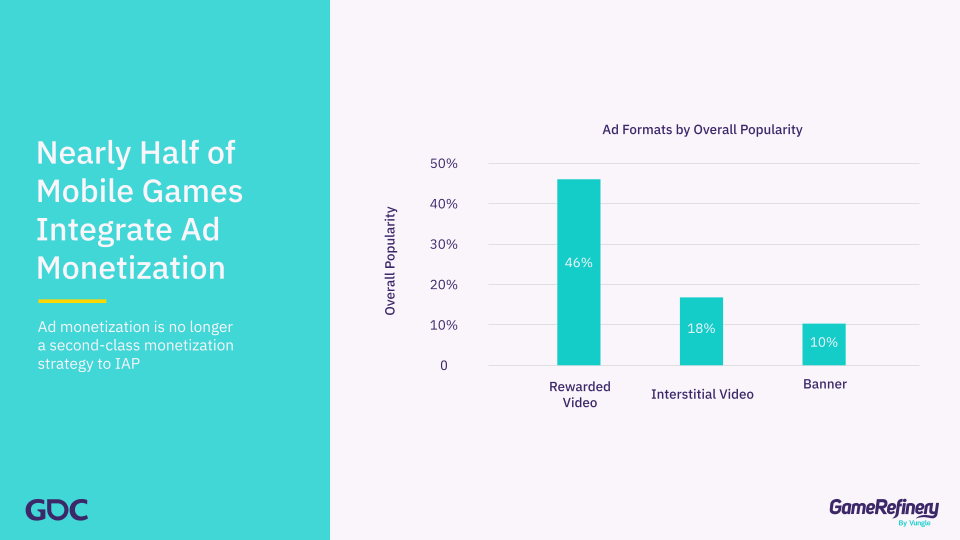
But here (above) you can see how far things have evolved. Nearly half of the top 100 grossing games have incentivized or rewarded video integrated into the game experience. And mobile game developers aren’t integrating just one ad placement. We found that 8% of the top 100 grossing mobile games and 18% of mobile games outside the top 100 have at least 5 or more ad placements in their games.
So we know that a lot of mobile games use ads to monetize, but the question is how to implement in-app ad placements. It can be one of the most important choices a developer can make. And with so much at stake, you need to carefully evaluate how to balance the trade-off between earnings and player experience. While the right choice can unlock a highly profitable revenue stream for your mobile game, the wrong one could accelerate churn or even cannibalize other revenue streams.
The good news is that people have come to appreciate that playing free mobile games does still come with some sort of a “price,” meaning they understand that you, the game developer, aren’t running a charity and you need to find a way to make money somehow. Engaging with ads is one way players can, in effect, tip their game makers for the enjoyable time spent playing. To help game developers balance the trade-off between game experience and monetization, we decided to conduct the first-of-its-kind analysis of ad formats to find out just which ad placements, at which time in the game experience, generate the highest eCPMs.
Related: 2021 In-App Ad Placement Revenue Report
We conducted an analysis of ad placements on our network to help guide mobile game developers in implementing the most delightful and lucrative placements. Our study analyzed over 6.3 billion ad impressions served across 150 different placements within the Vungle ad platform. And that was over the period of time from January to September of last year. In order to actually actionably evaluate the efficacy of the industry’s most common ad placements, all 150 of the placements analyzed in the study were assigned 1 of 5 different user experience categories meant to capture when in the user experience the ad is actually shown. The result is a series of unique combinations of ad formats like rewarded or interstitial, etc., and UX categories like end of level, rewarded section, etc., that have been analyzed holistically. So we’ve determined the most valuable approach to ad implementation for mobile game developers. We analyze the 3 most common ad formats in mobile game monetization: rewarded, interstitials (and that interstitial could be static, video, or a playable), and banners.
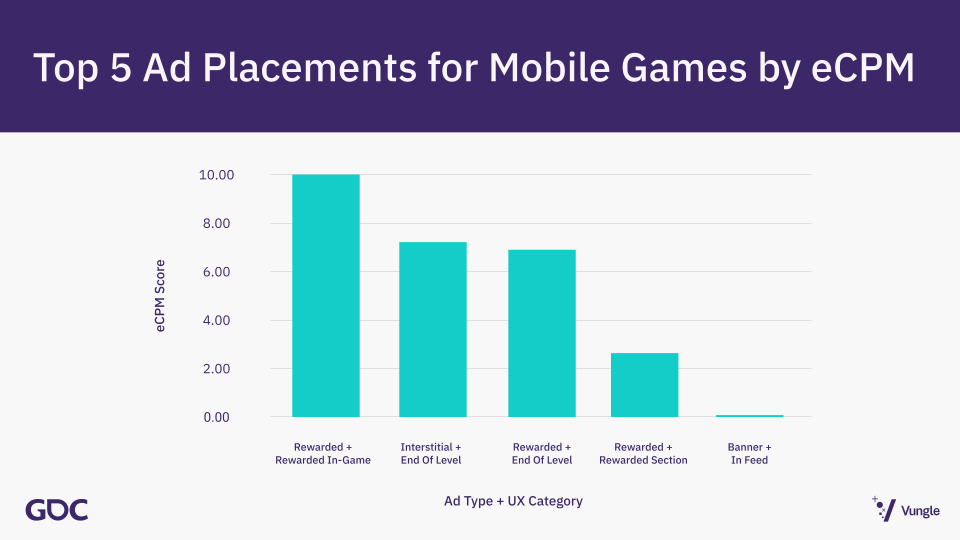
And the results (above) show that of all mobile game placements, the highest eCPMs come from rewarded ad prompts that were contextually integrated into gameplay to offer clear and immediate value to players. This includes ads that might be triggered during core gameplay, where a user can be offered some form of game progression or mechanical modifier as a reward. For example, a user might earn virtual currency, activate upgrades, or receive relief from in-game difficulty in exchange for engaging with an ad. Interstitials also proved to be valuable for mobile game developers. Especially when placed at the end of a level where their unprompted nature doesn’t interrupt the player experience. And these interstitials were followed closely by rewarded ads placed at the end of gameplay, where they often offered players the chance to multiply their score or continue the game in exchange for watching an ad. Finally, rewarded ad placements within dedicated menus, and banner ads deployed within various moments of a game, offer mobile game publishers reliable revenue. Though their lower eCPMs likely necessitate a higher volume of impressions.
So we’ve discussed some of the data. Now, I’m going to show you some specific examples of ad placement experiences from Vungle publishers and highlight why these placements work so well. So let’s dive in.
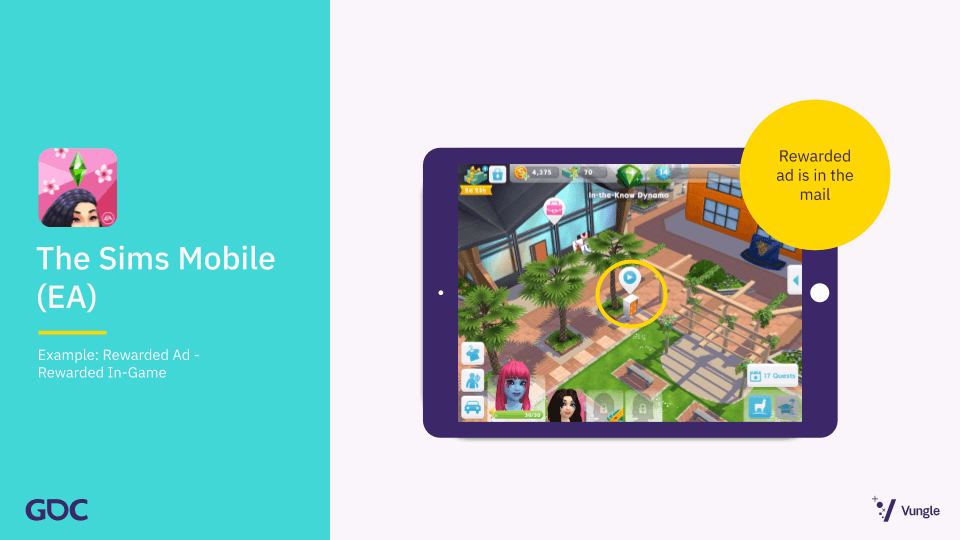
For our first example, we take a look at a rewarded ad delivered within the game experience. This is The Sims Mobile, gaming giant EA’s mobile take on the hit Sims franchise. In The Sims Mobile, players are occasionally offered the option to tap on the mailbox outside of their home in the market square area, as shown in this game image (above). They can interact with a rewarded ad in return for in-game currencies or other items. I should note that this is just one of many similar examples of how EA incorporates in-game rewarded ads. They offer similar experiences after completing relationships, work tasks, or hobby events, where players are presented the opportunity to interact with a rewarded ad.
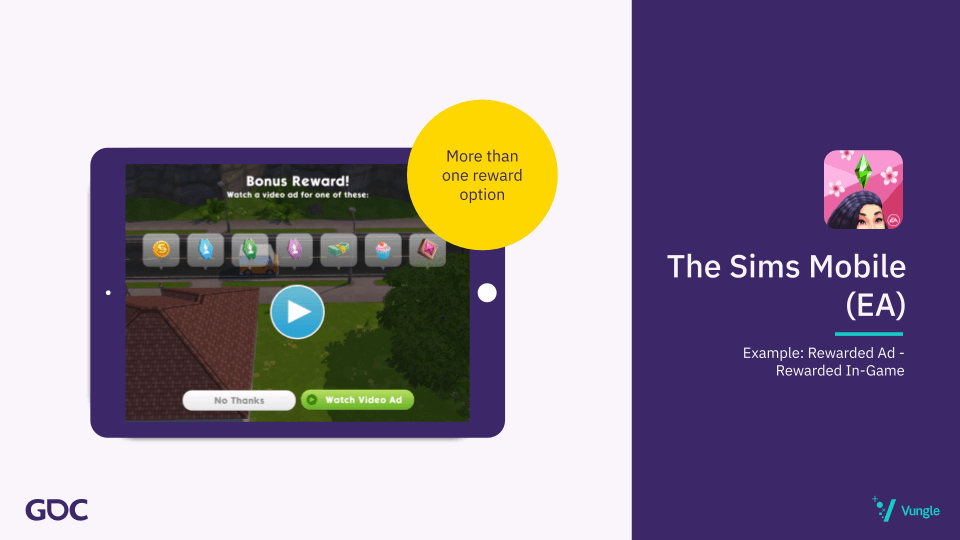
In this image (above), you can see the mailbox rewarded ad mechanic showing that the possible items or currencies players can receive, such as Heirloom Tickets, SimCash, and more, in exchange for watching the video ad presented. So let’s take a look at what this ad placement looks like in action.
All right, so why did this work? We can boil it down to 3 primary reasons. One, it’s authentic. The mailbox mechanic perfectly suits the virtual world of The Sims. And the same way people make a habit of checking their home’s mailbox every day, players in The Sims do the same thing — checking their virtual world’s mailbox. Two, it’s transparent. This placement clearly and visually shows the types of currencies and items a player would receive in return for engaging with an ad. Lastly, it’s opt-in. While this best practice applies to any kind of rewarded ad placement, we wanted to get this point across in our first example. The mailbox placement works because it’s a completely optional experience for the player.
Now, let’s take a look at an interstitial end-of-level ad placement example. Here, I’m going to show Pocket Gems’ interactive storytelling game called Episode. In Episode, Pocket Gems places players in the shoes of the main character in the stories. And the stories are about love, romance, and adventure. Similar to one of those choose your own adventure books, players are the ones who make the choices to determine the ultimate outcome of a story. So how does Pocket Gems make ads fit into Episode’s core loop? Let’s take a look at a quick video. As you’ll see here at the end, on occasion between episodes of a story, Episode runs an interstitial ad. What I especially like about this example is that they position the ad as a pseudo commercial break — as if the experience is brought to you by an actual sponsor, which it kind of is.
So why does this end-of-level placement work so well? First, it’s natural. Episode, while a mobile game, is actually no different than an episodic show on TV, YouTube, or any streaming service for that matter. Pocket Gems’ Episode runs commercials at natural breaks in the content in the same way episodic shows do. It’s also fair. Playing a single episode to a story takes the player at least a few minutes to reach the end. In a fair trade for a player to play an episode for free in exchange for viewing an ad at the end — that’s a fair trade-off. Finally, it’s actually refreshing. Considering that each episode of a story can last for at least a few minutes, this end of level placement acts as a palette cleanser to the player, where the player can take their mind off the game for a brief moment to learn about an advertised game, an app, or products they may be interested in.
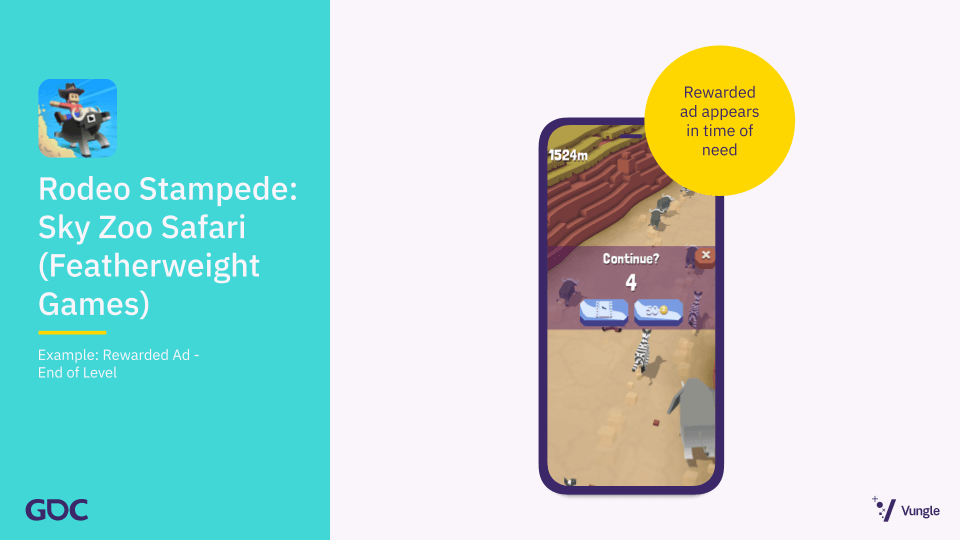
The next example (above), we have another rewarded ad format. This time it’s an ad placement that we call “end of level”. This one comes from Rodeo Stampede: Sky Zoo Safari from Featherweight Games. Rodeo Stampede is an endless runner game where the players are tasked with riding as far as they possibly can on the backs of all kinds of different animals. If the player crashes and falls off their ride at any point, they’re given the option to continue their run by engaging with a rewarded ad. Or otherwise, they can restart their run from the beginning. Let’s see how this ad placement experience plays out in motion.
So this placement works because [of] loss prevention. Imagine a player at the precipice of breaking their personal run record, but crashing with only a few meters to go. At these moments, in the minds of the players, their loss of aversion instincts kick in. This is the game maker’s opportunity to lend a helping hand by allowing the player to continue their run. There’s also a sense of urgency. A countdown timer creates a sense of urgency in the mind of the player. If you don’t act quick enough, you lose your spot in the game. And lastly, it’s delayed. You may have noticed that in the video I showed, you never saw the actual ad. After a player confirms to engage with a rewarded ad to continue a run, the ad isn’t actually served directly, but instead, the player can keep playing. Only once they fail a second time will the ad actually deploy. This delay allows the player to continue their run from where they left off without interruption until they fail the next time.
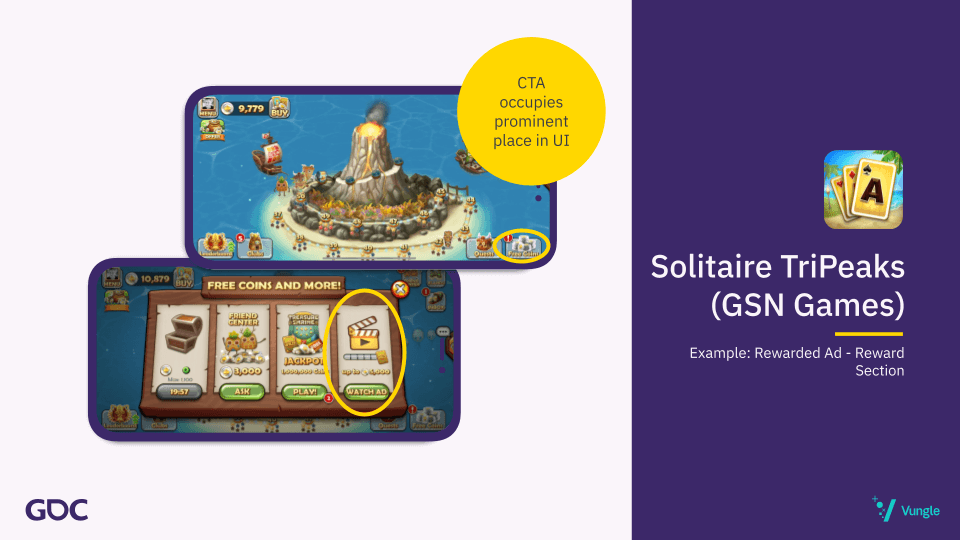
All right, in this final example, I want to highlight a different type of rewarded ad. GSN Games’ Solitaire TriPeaks created a rewarded section within the primary game UI. In this top image (above), you can see the main home screen of the game, and a button to get free coins is prominently placed in the bottom right of the screen. When selected, players are offered more than just one way of receiving free in-game currency. But let’s hone in on the rewarded ad placement. After you watch an ad to completion, a player is presented with three flipped-over cards, each with a different amount of coin rewards. This is a tried-and-true gacha mechanic but in the form of a reward for a rewarded ad. Here’s what I’m talking about.

Another unique element of the ad experience in Solitaire TriPeaks is that they let you double down on the rewarded mechanics (as seen above). If a player watches a few ads in a row, they have the opportunity to earn one Wild Card in-game item, and that’s valued at $0.99.
So this placement works because, first, there’s an element of surprise. Rather than the value exchange being something completely fixed by the developer, GSN offers three reward options. The gacha-like mechanic adds a level of surprise, where the player could earn between a few hundred coins to a few thousand coins. It’s also visible. GSN doesn’t hide the CTA to engage with ads in return for rewards in places such as in the game store or somewhere else where a non-paying player may never end up. Rather, they put a CTA to access free rewards on the most frequented sections of Solitaire TriPeaks, the game’s overworld screen. This is a best practice for mobile game developers, thinking about where to place rewarded ads in non-gameplay areas. Don’t be ashamed of rewarded ads by tucking them away in some deep dark corner of your game that no one sees.
Finally, it’s generous. Solitaire TriPeaks is generous in 2 ways. First, the potential for the player to earn a lot of coins through the card-flipping gacha mechanic. And second, after multiple ad views, players are given a Wild Card in-game item that’s valued at $0.99. For only a few minutes of their time, players can earn a dollar’s worth of premium content. Through this small gesture of generosity, GSN has given the player a taste of the premium content experience that could potentially lead to the player playing longer or convert into a payer.
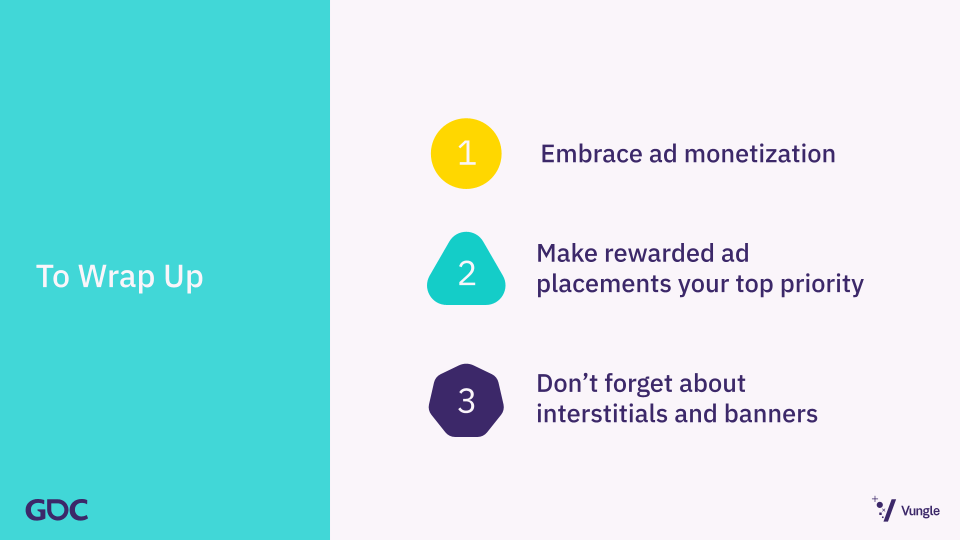
So to wrap things up. First of all, embrace ad monetization. The message is loud and clear — our data shows that nearly half of mobile games monetize through a hybrid approach of in-app purchases and rewarded video or other ad formats. Also, when you embrace ads, start with rewarded. Results of our report demonstrate that rewarded ad implementations generate the highest value for mobile game developers pushing into ad monetization. But, don’t forget about interstitials and banners. Interstitials remain a strong contributor for anyone looking to diversify their ad strategy. And explorations into display format should probably start with MREC and then move into more traditional banners like the 320x50s.
So that’s it. Thanks so much for joining me today. If you want to learn more about Vungle and how we can help grow your business, you can scan this QR code on your screen to send an email to me at [email protected]. And for more insights like this that we publish on a regular basis, you can bookmark our blog at vungle.com/blog. Thanks again, I appreciate all your time.